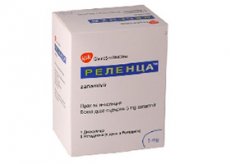Medical expert of the article
New publications
Preparations
Relenza
Last reviewed: 04.07.2025

All iLive content is medically reviewed or fact checked to ensure as much factual accuracy as possible.
We have strict sourcing guidelines and only link to reputable media sites, academic research institutions and, whenever possible, medically peer reviewed studies. Note that the numbers in parentheses ([1], [2], etc.) are clickable links to these studies.
If you feel that any of our content is inaccurate, out-of-date, or otherwise questionable, please select it and press Ctrl + Enter.

Relenza is an antiviral drug.
 [ 1 ]
[ 1 ]
Indications Relenza
It is used for the treatment or prevention of infections, the activity of which is provoked by influenza viruses of type A or B. The use of the drug helps to reduce the symptoms of the disease and significantly reduce its duration.
Release form
Pharmacodynamics
The drug is a highly selective neuraminidase inhibitor. Neuraminidase is a surface enzyme of the influenza virus; it has the ability to release cells and accelerate the movement of the virus through the mucosal barrier to the surface of epithelial cells, resulting in infection of other cells of the respiratory tract.
The mucous membrane inside the respiratory tract treated with zanamivir retains the virus that gets on it, preventing it from penetrating into the epithelial cells. When already affected cells of the respiratory ducts and nasopharynx are treated, the spread of the virus inside the body stops. The drug does not penetrate into the cellular space, exerting its effect in the extracellular area.
The drug is highly effective in preventing the development of influenza. Compared with the placebo group, its effectiveness is within 67-79%, and compared with the active observation group, within 56-61%.
Pharmacokinetics
When administered via inhalation, its bioavailability is only 2%. The level of systemic absorption is approximately 10-20%. With a 1-time use of a dosage of 10 mg, the Cmax values are noted after 75 minutes and are 97 ng/ml. Since the drug has a low degree of absorption, its plasma indicators are also low.
The active ingredient is distributed within the respiratory system tissues after the inhalation procedure. The substance levels after 12 and 24 hours from the moment of inhalation are, on average, 340 and 52 times higher than the average half-maximum inhibition level of the virus neuraminidase, respectively. The large amount of the medicinal component within the respiratory tract ensures rapid inhibition of the virus neuraminidase activity.
The drug accumulates within the lung tissue (13.2%) and the oropharynx tissue (77.6%).
It is excreted unchanged through the kidneys, without undergoing metabolic processes. The half-life of the substance after inhalation is 2.6-5 hours. The level of total clearance is within 2.5-10.9 l/hour.
Dosing and administration
The medicine must be administered using a special inhaler, a diskhaler, which is included in the medicine package along with the powder. For any age, a standard dose of 20 mg per day is used. In order for the therapy to have maximum effect, inhalations should be started immediately after even mild manifestations of the disease are detected.
The substance must be administered in 2 doses (each dose is 10 mg of zanamivir in the form of inhalation - 2 procedures of 5 mg). The duration of use of the medication is 5 days.
For prophylactic purposes, the drug can be used for ten days, two inhalations (10 milligrams of the active substance) once a day. If the risk of infection remains, prophylactic use can be extended to one month.
Use Relenza during pregnancy
The drug should not be prescribed during the first trimester of pregnancy.
Side effects Relenza
The use of the drug may provoke the occurrence of the following side effects:
- epidermal reactions – urticaria, Stevens-Johnson syndrome, erythema multiforme and TEN;
- difficulty breathing;
- bronchospasm;
- manifestations of allergy - swelling of the larynx or face;
- social deviation;
- hallucinations, delirium, or seizures.
Overdose
The probability of accidental intoxication with Relenza is extremely low. In the case of intentional increase of the dose to 64 mg per day, the development of negative symptoms was not noted.
In the case of parenteral administration of the drug in a dose of 1200 mg per day for 5 days, no negative signs were recorded either.
Storage conditions
Relenza should be kept at temperatures not exceeding 30°C.
 [ 23 ]
[ 23 ]
Shelf life
Relenza can be used within 5 years from the date of manufacture of the drug.
Application for children
Not for use by children under 5 years of age.
 [ 24 ], [ 25 ], [ 26 ], [ 27 ]
[ 24 ], [ 25 ], [ 26 ], [ 27 ]
Analogues
Analogues of the drug are such drugs as Virolex, Virgan, Amizon, Valtrex and Virogel with Nucleavir and Rebetol, as well as Acyclovir.
 [ 28 ], [ 29 ], [ 30 ], [ 31 ], [ 32 ]
[ 28 ], [ 29 ], [ 30 ], [ 31 ], [ 32 ]
Reviews
Relenza has a high therapeutic efficiency, significantly weakening pathological symptoms after the first inhalation procedures. Also, reviews indicate that the use of the drug rarely causes the appearance of side effects.
Attention!
To simplify the perception of information, this instruction for use of the drug "Relenza" translated and presented in a special form on the basis of the official instructions for medical use of the drug. Before use read the annotation that came directly to medicines.
Description provided for informational purposes and is not a guide to self-healing. The need for this drug, the purpose of the treatment regimen, methods and dose of the drug is determined solely by the attending physician. Self-medication is dangerous for your health.

